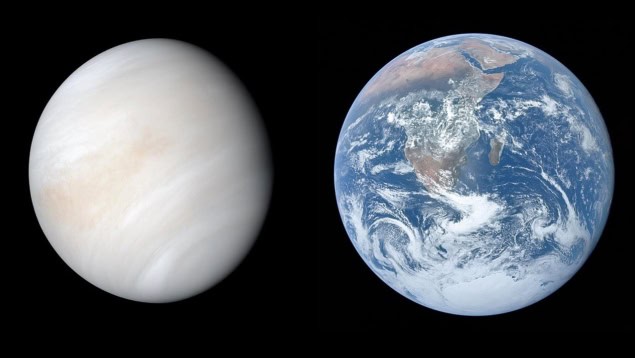
Venus could be shedding water to space at a much faster rate than previously thought. That is the conclusion of researchers in the US, who have identified a mechanism in the Venusian ionosphere that could be involved in water loss.
How much water Venus had in the past is uncertain, with some planetary scientists suggesting that the planet may have once had oceans that eventually evaporated as the Venusian greenhouse effect began to run away with itself. Today, only 0.002% of the planet’s atmosphere is composed of water vapour. If condensed on Venus’ surface, this water would form a global equivalent layer (GEL) just 3 cm deep – compared to Earth’s GEL of 3 km.
If Venus began life with a large amount of water, then it has lost almost all of it. Current thinking is that non-thermal hydrogen escape is responsible. This process involves solar radiation splitting water molecules into oxygen and hydrogen. Being lightweight, some of this hydrogen will then escape into space and be swept away by the solar wind.
Lost forever
“Once a hydrogen atom has gone, Venus has lost, in some sense, a water molecule forever,” says Mike Chaffin of the University of Boulder, Colorado.
In recent years, Chaffin’s team have explored water loss from planetary atmospheres via a different mechanism involving the formyl cation (HCO+). This ion is a product of molecular recombination in a planetary ionosphere after molecules such as water and carbon dioxide are broken apart by solar radiation. In their model, Chaffin and his colleagues describe the dissociative recombination of HCO+, whereby an electron that has been liberated when an atom or molecule is ionized then collides with the ion, splitting HCO+ apart into carbon monoxide(CO) and an energetic hydrogen atom. This “hot hydrogen” has enough energy to escape the planet’s gravity.
In 2023, Chaffin and colleague Bethan Gregory found that HCO+ dissociative recombination is responsible for 5–50% of the water loss from Mars’ ionosphere.
However, when Chaffin, Gregory and Eryn Cangi led their team to apply the same mechanism to Venus’ atmosphere, the models showed that HCO+ dissociative recombination must be the dominant form of water loss on the planet, doubling the previously calculated rate of water loss.
Lack of data
The problem is, HCO+ has yet to be detected on Venus.
“I worried about this a lot when we were preparing our paper [describing our results],” Chaffin told Physics World. “Based on our modelling work, there should be a lot more HCO+ on Venus than we thought previously, but how much can we trust our model?”
Chaffin says that the uncertainty is related to NASA’s Pioneer Venus Orbiter, which has been the only space mission so far with an instrument capable of probing Venus’ ionosphere. Launched in 1978, Pioneer was not specifically designed to detect HCO+.
“This has been a gap in measurements of Venus,” says Chaffin, although he does say that by extrapolating from the Pioneer results, one can infer a water-loss rate that is “in the same ballpark” as that predicted by the HCO+ mechanism. Chaffin takes this as indirect confirmation of the model.
Chaffin’s confidence is backed up by Janet Luhmann at the Space Sciences Laboratory at the University of California, Berkeley. “So long as [Chaffin and colleagues’] assumptions are accurate, there is no reason I can see to dismiss this concept,” she says.
Water sources
If true, then the HCO+ dissociative recombination model changes the history of water on Venus, somewhat. If Venus did have oceans, then some of its surviving water vapour will originate from those oceans, some will come from outgassing via volcanoes, and the remainder arriving through comet and asteroid impacts.
The increase in the escape rate means that if Venus did once have oceans, compressing the time it takes to lose that water to space thanks to the efficiency of the HCO+ mechanism means those oceans could have survived on the surface for longer. If Venus never had oceans, then either the rate of outgassing or the rate of impacts, or both, must be higher to at least keep pace with the speed of water loss.

Controversy erupts among astronomers over whether phosphine really was discovered on Venus
Unfortunately, forthcoming missions to Venus may not be able to confirm the presence of HCO+. Neither Europe’s Envision mission, planned to launch in 2031, nor NASA’s DAVINCI spacecraft that will blast off in the late 2020s, will study the ionosphere.
However, Sanjay Limaye of the University of Wisconsin, Madison points out that Russia has proposed an instrument for India’s planned Venus orbiter that may be able to detect HCO+ around 2031.
However, Luhmann, who specializes in studying the interaction between the solar wind and planetary atmospheres, thinks there might be another way. The escaping hot hydrogen from the HCO+ dissociative recombination process is moving fast. Whereas Chaffin believes it will be too fast to detect, Luhmann is not so ready to dismiss it.
“In-situ measurements of hydrogen pickup ions may be useful if they are sensitive enough and can distinguish the characteristic initial energies of the escaping neutrals before they are ionized,” she says, pointing to previous work on Mars that has accomplished the same thing.
The research is described in Nature.



